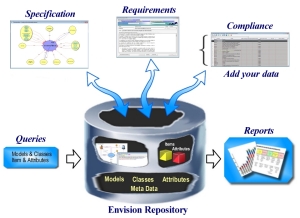
|
Solution: Envision System Engineering |
|
Improves performance and quality of the
system engineering process
Functional analysis - Requirements - Compliance...
|
The
 (the French
railways) uses it for designing its "TGV," why not you? (the French
railways) uses it for designing its "TGV," why not you?
Engineering activities
integration tool
Starting
from your needs analysis, we integrate systems engineering activities and
associated information in a centralized and multi-user repository.
Together, we create a flexible and effective engineering process, ideally
suited for your business and that ensures the quality of your projects
following the ISO, CMMI or AFAQ standards.
Information and prices 
|
with an integrated
engineering tool

See details on standard activities
|
Details for pre defined activities to
integrate
Details for specific activities integrated for ours customers
|
|
Solution key points
-
Incorporates the principles for quality in order to obtain an ISO-AFAQ-CMMI
certification
-
Setup a flexible system
engineering process which respect your methodologies, business and historic
-
Centralizes, manages and develops real-time sharing of all information
within a single and multi users with links to internal traceability, as well
as external documents
-
Improves the efficiency and added value of responsible business leaders and
responsible systems of education
-
Professional and formalizes communication with bidders and to avoid
conflicts
-
Increases customer satisfaction final
-
Does
not require specific spending for administration of the tool
|
Consulting
and services
-
Management of functional analysis sessions
-
Integration
of existing data
-
Systems engineering process architecture
and integration
-
Technology transfer
|
Information leveraging solutions
tailored to each enterprise and its projects.
In France since 1989
 |
|
Value analysis |
|
Value
analysis is used to track costs associated with each functions
of a product or service and to avoid redundancy.
The aim
is to check, for each function, its ability to cover a real need,
what does it cost and how it can be reduced. The analysis may also
focus on value added at each stage of the manufacturing process.
The meta
tool allows the definition of precise criteria for values
(quantity - cost - added value - exchange value ...) and to
implement calculations with macros defined by the user.
Scenarios are then evaluated and analyzed and the best
solution is identified. It is a decision aided tool. |
|
|
Expression of the need -
Functional analysis |
|
The expression
of the fundamental need (E.F.B.) followed by the functional analysis (F.A.)
allow the production of the Functional Schedule of Conditions (functional
report). The
goal is to make sure that the functions of the product, service or system
will satisfy the users expectations. The F.A. aims at improving quality while
being interested in the functions of the project. |
|
Phases |
Deliverables |
| Expression
of the need |
-
Need validation
-
Need requirements matrix
|
|
External functional analysis |
-
norm NF X50-150
-
Requirements matrix
-
Crossover matrix
|
|
Internal functional analysis |
-
Technical
specification report
-
Functional architecture
|
|
Architecture proposal |
|
|
|
Risks analysis |
|
General - Safety and
security
A
fast developing activity in the industry in close association with
quality assurance and promotion conducted by the Institute for
Security Operations. It follows a functional analysis with which it
is closely linked.
Module A for general risks analysis and module B for systems
failure risks analysis are associated within the MOSAR methodology
in order to obtain an integrated tool with traceability over the
risks information repository.
Risks analysis and prevention documents of
the whole project or for one of its subsets are automatically
generated.
|
|
|
Requirements engineering |
|
The
management of requirements and their evolutions over the life's cycle of a
product, system or service makes it possible to deliver solutions in conformity
with the users expectations, within the time limits and removes many problems:
Fuzzy or ambiguous requirements, not exploitable schedule of conditions, misses
visibility, changes not controlled, unknown project status and impact analysis
impossible to carry out. |
|
Steps |
Deliverables |
|
Requirements management |
-
Requirements hierarchical matrix: norm NF X50-150
-
Requirements/criteria/levels evolution matrix
-
Open issues matrix
-
Approval inquiry
for change on linked requirements (e-mail sending)
|
|
|
Examination of invitation to tender |
|
To analyze the
answers of each sub contractor following an invitation to tender with an aim of
selecting the best offer is a delicate, long, tiresome task with technical, financial and political consequences. An approach of rational and
exhaustive analysis of the answers allows the detailed notation of each
requirement of FSoC. This step, used for large projects, makes it possible
to identify the winner while minimizing the risks. |
|
Steps |
Deliverables |
|
Examination of all answers following an invitation to tender
Selection of the best sub contractor |
|
|
|
Expertise engineering |
|
The
expertise engineering includes engineering data management over the
product's life cycle. It deals with all specifications, design and
conformity documents defined in the Production Documentation Plan (PDP).
It allows project achievement control and help verifying the
requirements conformity phase by phase in order to anticipate corrective
decision. |
|
Phases |
Deliverables |
| Business
management |
-
Business sheet
-
Sub systems sheets
-
Notification mailing
|
Conformity
follow-up with management of:
- Phases-Miles
stones
-
Mandatory
documents (received documents)
-
Status
|
-
Documents matrix
(requested/received) by miles stones
-
Conformity status
matrix
-
Status historic
matrix
|
|
|
Project feedbacks management |
|
To
capitalize and manage feedbacks experience (knowledge) makes it possible to increase
efficiency, to avoid making twice the same errors, to improve the
solutions brought from one project to the other, to build the company
global added value. |
|
Steps |
Deliverables |
|
Feedbacks management
(intra and inter projects) |
-
Feedbacks search/filter matrix by key word
|
|
|

